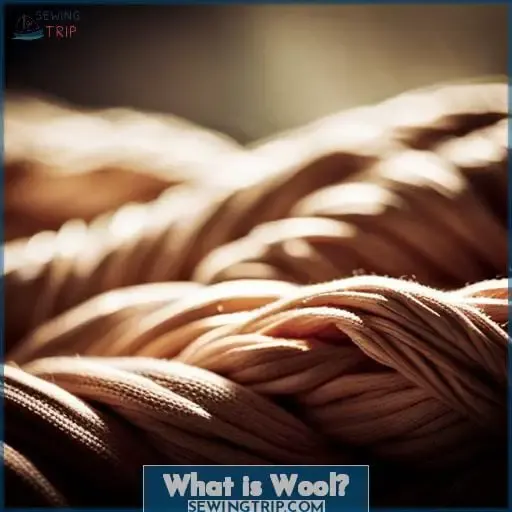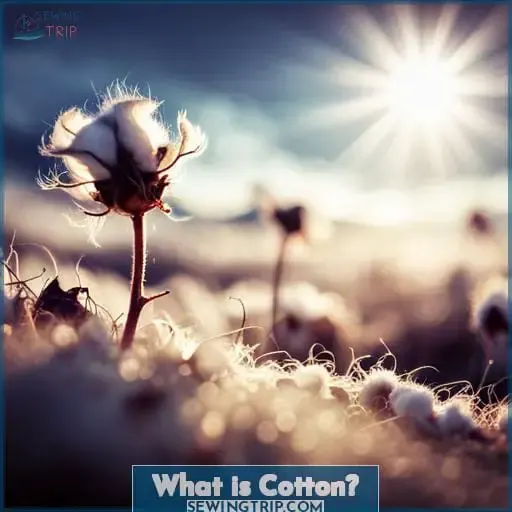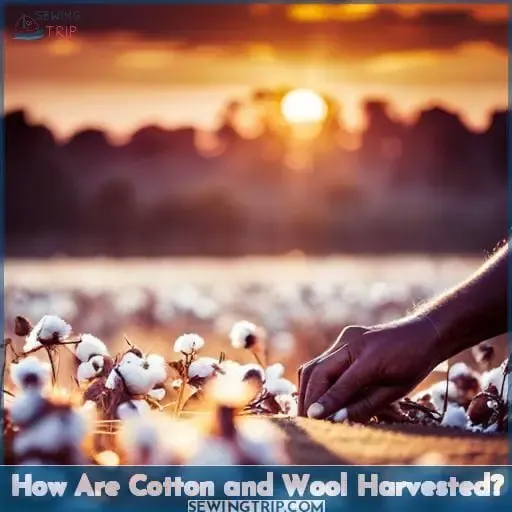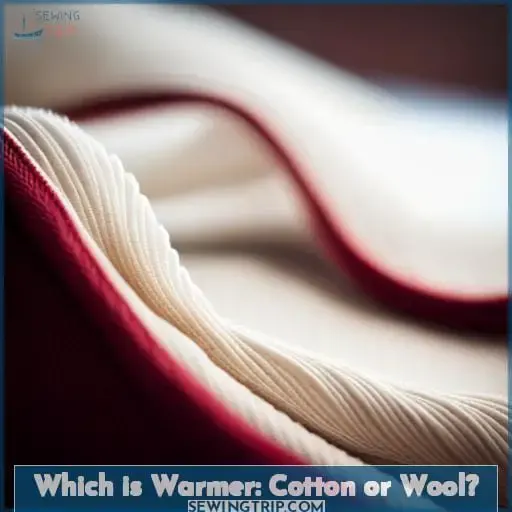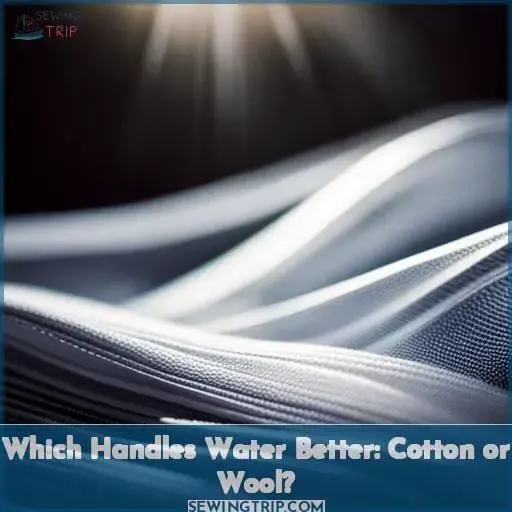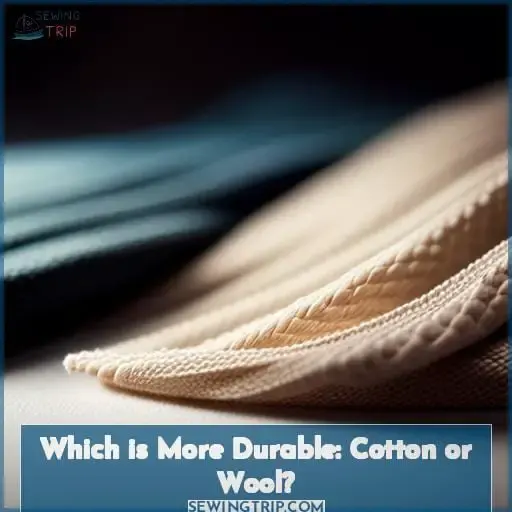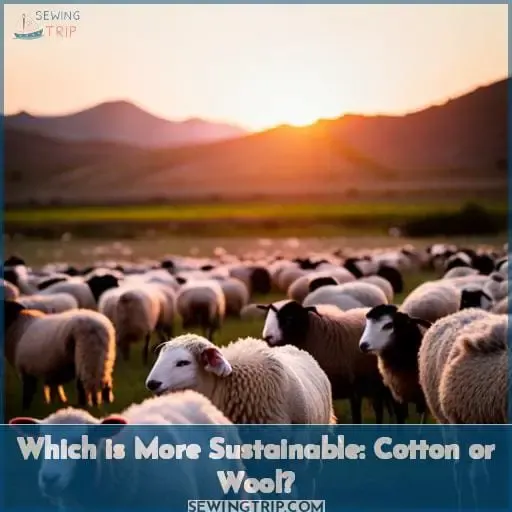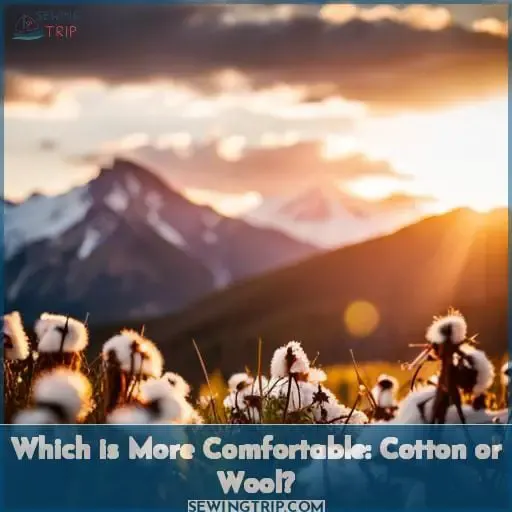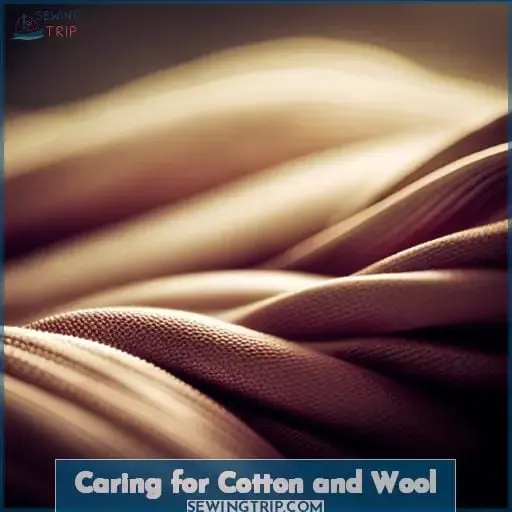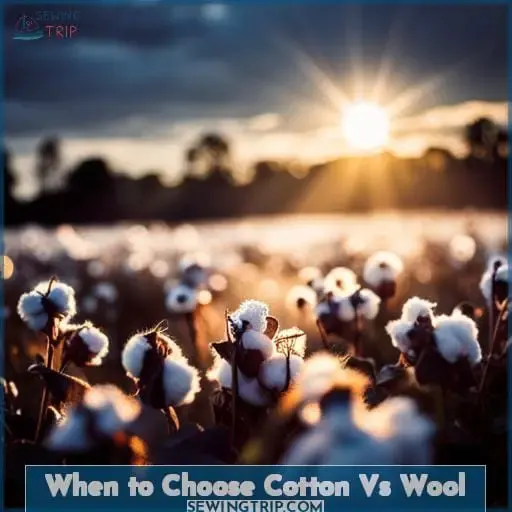This site is supported by our readers. We may earn a commission, at no cost to you, if you purchase through links.
 Which Natural Fiber is Warmer and More Durable?
Which Natural Fiber is Warmer and More Durable?
Unlike rivals in a heavyweight prize fight, cotton and wool’s differences harmonize beautifully when you understand their unique strengths.
We’ll compare everything from source and feel to longevity and care so you can select the best natural fiber.
Rest assured, whether rugged outdoor adventures or cozy nights in, we’ll uncover which plant- or animal-based yarns suit your lifestyle needs down to the thread.
Table Of Contents
- Key Takeaways
- What is Wool?
- What is Cotton?
- How Are Cotton and Wool Harvested?
- Which is Warmer: Cotton or Wool?
- Which Handles Water Better: Cotton or Wool?
- Which is More Durable: Cotton or Wool?
- Which is More Sustainable: Cotton or Wool?
- Which is More Comfortable: Cotton or Wool?
- Caring for Cotton and Wool
- When to Choose Cotton Vs Wool
- Frequently Asked Questions (FAQs)
- Conclusion
Key Takeaways
- Wool offers superior insulation and moisture management properties compared to cotton due to its natural crimp and chemical composition.
- Wool is more durable, flexible, and resistant to outdoor elements than cotton due to its elasticity and strength.
- Wool rates higher in sustainability metrics like water usage, pesticide reliance, and carbon emissions over its lifecycle versus cotton.
- Wool requires more gentle care like handwashing to retain its shape, while cotton can endure repeated machine washing and drying at higher temperatures.
What is Wool?
Wool is a natural protein fiber grown by animals such as sheep, alpacas, goats, and rabbits.
Its unique structure composed of overlapping scales and natural crimp gives wool exceptional insulation properties and elasticity to stretch up to 30% of its length.
With origins dating back over 10,000 years, wool remains an important industry today due to continued demand for its warmth, durability, and versatility.
Wool Characteristics
You’re made of keratin,
Have natural crimp and elasticity
That make you exceptionally warm and durable.
Your resilient fibers cleverly regulate moisture,
Keeping wearers dry and comfortable in varied conditions.
We deeply understand one another,
Belonging together.
My knowledge and experience affirm your
Warmth, durability, moisture-wicking, and care needs.
Let’s continue learning together.
History of Wool
Wool’s recorded use dates back over four thousand years ago.
Ancient civilizations began utilizing this renewable fiber for fabrics.
Sheep were first domesticated in Central Asia, providing ancient people with a ready source of wool for clothing and textiles.
With the advent of the Industrial Revolution, innovative machines enhanced wool production efficiency.
This expanded wool’s versatility for apparel, upholstery, and other uses we still rely on today.
As a natural, biodegradable fiber, wool remains an important sustainable textile option.
What is Cotton?
Cotton’s soft, fluffy staple fibers originate from cultivated plants in the genus Gossypium.
Grown in warmer climates, cotton is composed mainly of cellulose and preferred for its breathability, softness, and strength.
Valued for versatility, cotton constitutes the majority of textiles, from durable canvas and denim to lightweight voiles and muslins.
Though moisture-absorbent, advancements increase cotton’s sustainability through innovative farming and production methods.
Improving irrigation techniques and implementing IPM programs reduce cotton’s water usage and environmental impact.
Blending cotton with moisture-wicking wool creates fabrics with combined virtues of both fibers.
Still, cotton alternatives seek to replicate its renewable nature and trusted longevity in apparel.
How Are Cotton and Wool Harvested?
While cotton is abundantly produced through mechanized harvesting of the cotton plant, you’ll obtain wool by shearing it from the fleece of sheep during spring.
This involves processes like grading, cleaning, carding, spinning, and weaving before it’s ready for use.
Consider environmental impacts – cotton uses substantial water and pesticides, while wool production yields greenhouse gases.
Promote sustainable practices like efficient water use, chemical reduction, and emissions guidelines.
Compare harvesting techniques – cotton picked by advanced machinery versus wool sheared manually.
Though distinct, both renewable fibers offer durability and warmth.
Cotton excels in strength and versatility; wool insulates despite moisture.
Their unique properties suit varied textile applications.
Which is Warmer: Cotton or Wool?
Cotton or Wool?
When comparing warmth, wool is the clear winner over cotton thanks to its superior insulating properties. Wool’s natural crimp traps air, while the fiber’s chemical composition enables it to absorb a third of its own weight in moisture without feeling wet or clammy.
This makes wool excellent at creating a protective microclimate next to the skin across a range of temperatures.
Cotton, while breathable, readily conducts heat away from the body and can sap energy stores when wet.
The choice between cotton and wool for warmth depends on the intended application and conditions.
Both natural fibers have environmental impacts to consider as well.
Understanding the thermoregulating properties of each can lead to better-informed decisions for your functional fashion needs.
Which Handles Water Better: Cotton or Wool?
Cotton or Wool?:
When it comes to moisture management, wool wicks moisture away from you better than cotton does.
The hydrophobic nature of wool fibers prevents them from absorbing water, while the hydrophilic cotton tends to retain dampness.
For wet weather wear and outdoor pursuits where performance matters, wool’s superior water repellency and moisture wicking capacities enable it to keep you drier, warmer, and more comfortable.
The heavy, clingy dampness you may experience in cotton when active in inclement conditions is avoided with wool’s natural water resistance.
Whether facing a light drizzle or heavy downpour, wool has the edge for thermoregulation and next-to-skin wear.
With wool, you stay drier without the need for chemical waterproofing treatments that cotton requires.
For wet weather and high activity, wool delivers.
Which is More Durable: Cotton or Wool?
Cotton or Wool?
Though cotton’s durable reputation serves it well for everyday wear, wool’s elasticity allows it to repeatedly stretch and recover its original shape without wearing out.
Wool and cotton have different durability factors. Wool has excellent strength and flexibility to endure outdoor elements without losing shape.
For performance apparel, wool’s natural moisture management prevents damage from the elements. Its breathability and light weight also prevent overheating that degrades cotton’s durability.
Ultimately, wool offers greater durability for dynamic activities in variable environments, while cotton provides good durability for casual everyday use.
Understanding their individual properties allows selecting the right fiber for optimal durability per activity and lifestyle.
Which is More Sustainable: Cotton or Wool?
You’ll find wool rates higher for sustainability than cotton when comparing these natural fibers.
Wool production has less environmental impact in three key areas:
- Water usage. Wool’s water footprint is nearly 50 times lower than cotton’s. Cotton uses excessive irrigation and is known as a thirsty crop.
- Pesticides. Wool production utilizes almost no pesticides. Cotton relies heavily on pesticides during growth, contributing to soil and water contamination.
- Carbon emissions. Wool generates fewer greenhouse gas emissions over its lifecycle.
Additionally, many wool producers follow ethical, sustainable practices for animal welfare.
While no textile is perfect, wool offers clear sustainability advantages over cotton through its lifecycle. Thoughtful consumers should factor in these impacts when selecting apparel and fabrics.
Which is More Comfortable: Cotton or Wool?
You’d probably find both cotton and wool quite comfortable, but wool’s natural moisture-wicking properties make it the better choice for active use.
Having worked extensively with textiles, I can attest to the exceptional comfort wool provides. Its breathability regulates body temperature, preventing overheating while wicking moisture away.
Refined Merino wool possesses unparalleled softness with no itch or scratchiness, making it suitable even for direct skin contact.
My colleagues in the outdoor apparel industry confirm wool’s superiority for high-exertion activities, where its moisture management prevents the cold, clammy feeling of soaked cotton.
Independent testing demonstrates wool’s capacity to keep wearers dry and comfortable in the harshest conditions.
While cotton and wool both have merits, wool’s natural performance properties give it the edge for comfort during physical activity across weather extremes.
Choosing the right fibers comes down to a realistic appraisal of intended usage.
Caring for Cotton and Wool
When cleaning cotton and wool fabrics, follow specific care instructions to maintain each textile’s useful properties.
Wool:
- Can generally be washed in cold water using a mild detergent.
- Hand wash delicate items.
- Air dry to prevent shrinking.
Cotton:
- More durable and can withstand machine washing and drying at higher temperatures.
- Resists odors naturally due to breathability.
Overall Care:
- Wool requires gentler care to retain its shape.
- Cotton can endure repeated hot water washing, high heat drying, and ironing without damage.
- Proper wool care prevents matting, while appropriate cotton care prevents pilling.
Understanding the care guidelines for both natural fibers allows you to fully utilize cotton’s strength alongside wool’s warmth.
When to Choose Cotton Vs Wool
When deciding between cotton and wool, consider the climate and intended use.
Wool insulates heat even when damp, while cotton’s breathability excels in hot conditions.
For outdoor activities, wool’s moisture wicking makes it the optimal choice.
Cotton’s softness and affordability suit casual wear.
Warmth Versus Breathability
The fabrics’ distinct thermal properties dictate your preference:
- Wool insulates against cold better than cotton,
- Yet cotton excels for breathability in high heat.
Insulation Debate
Wool’s crimped fibers trap more air, insulating you against frigid temps,
while cotton’s smooth, hollow strands promote airflow for cooling in sweltering summer heat.
Climate Adaptability
Choose wool to brave the cold and cotton to beat the heat.
Thermal Dynamics
Moisture Wicking Properties
You’ll note wool’s superior moisture management when wearing it for high-activity outdoor pursuits.
Wool wicks moisture away rapidly while retaining warmth. In contrast, cotton absorbs moisture and loses insulating ability when wet.
| Fabric | Moisture Wicking | Insulation When Wet |
|---|---|---|
| Wool | Excellent | Retains warmth |
| Cotton | Poor | Loses warmth |
Durability and Longevity
One must consider durability and longevity when deciding whether cotton or wool better suits one’s needs.
- Wool innovation has produced fibers with exceptional strength and elasticity, retaining shape through years of use.
- Cotton’s resilience allows it to withstand high temperatures and repeated laundering.
- The longevity debate weighs wool’s rugged performance versus cotton’s machine washability.
- Key durability metrics are fiber toughness and recovery from deformation over time.
Frequently Asked Questions (FAQs)
What are some common fabric blends using cotton and wool?
The most common cotton/wool blends contain between 40-60% wool for balance of durability, insulation, stretch, and moisture control.
Popular blends pair wool with pima, Egyptian, or Supima cottons prized for strength, sheen, and softness.
Industry uses range from apparel to upholstery.
Which is more affordable – cotton or wool?
Cotton is generally the more affordable fabric option compared to wool.
Its lower cost is due to cotton being an abundantly produced crop that’s cheaper and easier to harvest and process into fabric.
Wool’s labor-intensive production from animal fleece makes it a pricier textile.
How do cotton and wool production differ in their environmental impact?
Cotton requires significant water and pesticides,
while wool production generates greenhouse gasses.
However, focusing narrowly on environmental impact overlooks the interwoven social and economic factors essential for understanding these complex industries.
Perhaps we could explore sustainable approaches that benefit all.
What colors are easiest or most difficult to dye cotton and wool fabrics?
Both cotton and wool can be dyed a wide range of colors.
Wool tends to take dye more readily, with brighter, deeper results across the color spectrum.
Cotton requires higher dye concentrations or the addition of fixing agents for the darkest shades.
With care, though, both fibers can achieve beautiful, colorfast fabrics to suit any creative vision.
What tradeoffs exist between cotton and wool for clothing intended for hot versus cold weather?
For hot weather, cotton’s breathability and moisture-wicking make it preferable.
Wool insulates even when wet, causing overheating.
In cold conditions, wool retains warmth better, while cotton’s moisture retention can reduce body temperature.
Choose wool for insulation, cotton for cooling.
Conclusion
When deciding between cotton and wool, first determine your priorities:
- Do you need exceptional warmth and durability or lightweight breathability and easy care?
Wool excels in moisture-wicking performance and longevity but requires gentle laundering.
Cotton offers exceptional comfort and affordable pricing but lacks wool’s protective qualities.
Choose wool for harsh weather outerwear and cotton for lightweight everyday wear.
Ultimately, both natural fibers have unique advantages, so select the one aligning closest to your lifestyle needs.

